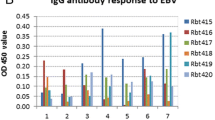Summary
Euthymic (SD or outbred rnu/+) and athymic (rnu/rnu) rats were inoculated oronasally or intraperitoneally with the RV-Y strain of rat virus when they were 2 days or 4 weeks old. Clinical signs of infection in athymic infants were similar to those in euthymic infants, but significantly more athymic infants died. Some infants developed anemia and thrombocytopenia. After inoculation of infants, RV-Y was detected in surviving euthymic rats for 7 weeks and in surviving athymic rats for at least 10 weeks. After oronasal inoculation of 4 week-old rats no clinical illness was observed. RV-Y persisted less than 6 weeks in juvenile euthymic rats but at least 12 weeks in athymic juvenile rats. Intraperitoneal inoculation of juveniles resulted in infection for at least 6 weeks. The antibody response of athymic rats to RV-Y was significantly reduced compared to that of euthymic rats. These studies indicate that T cell deficiency increases the severity and duration of RV infection and imply that T cells are required for the full expression of resistance to RV infection. They also suggest that RV-Y induced anemia could serve as a model for human parvovirus-induced anemia.
Similar content being viewed by others
References
Anderson MJ, Pattison JR, Young NS (1987) Pathogenesis of parvovirus-induced disease in humans. In: Notkins AL, Oldstone MBA (eds) Concepts in viral pathogenesis, vol 2. Springer, New York Berlin Heidelberg, pp 261–268
Bienenstock J, Befus AD (1980) Review: mucosal immunology. Immunology 41: 249–270
Brinton MA, Blank KJ, Nathanson N (1984) Host genes that influence susceptibility to viral diseases. In: Notkins AL, Oldstone MBA (eds) Concepts in viral pathogenesis, vol 1. Springer, New York Berlin Heidelberg, pp 71–78
Casali P, Trinchieri G (1984) Natural killer cells in viral infection. In: Notkins AL Oldstone MBA (eds) Concepts in viral pathogenesis, vol 1. Springer, New York Berlin Heidelberg, pp 11–19
Coleman GL, Jacoby RO, Bhatt PN, Smith AL, Jonas AM (1983) Naturally occurring lethal parvovirus infection of juvenile and young adult rats. Vet Pathol 20: 49–56
Hsu S, Raine L, Fanger H (1981) The use of antiavidin antibody and avidin biotinperoxidase comples in immunoperoxidase techniques. Am J Clin Pathol 75: 816–821
Jacoby RO, Bhatt PN, Gaertner DJ, Smith AL, Johnson EA (1987) The pathogenesis of rat virus infection in infant and juvenile rats after oronasal inoculation. Arch Virol 95: 251–270
Jacoby RO, Bhatt PN, Jonas AM (1979) Viral diseases. In: Baker HJ, Lindsey JR, Weisbroth SH (eds) The laboratory rat, vol 1, biology and diseases. Academic Press, New York, pp 272–306
Leonard R, Ruben Z (1986) Hematology reference values for peripheral blood of laboratory rats. Lab Anim Sci 36: 277–281
Margolis G, Kilham L (1972) Rat virus infecton of megakaryocytes: a factor in hemorrhagic encephalopathy? Exp Mol Pathol 16: 326–340
Margolis G, Kilham L (1970) Parvovirus infections, vascular endothelium, and hemorrhagic encephalopathy. Lab Invest 22: 478–488
Novotny JF, Hetrick FM (1970) Pathogenesis and transmission of Kilham Rat Virus infection in rats. Infect Immun 2: 298–303
Oldstone MBA, Blount P, Southern PJ (1986) Cytoimmunotherapy for persistent virus infection reveals a unique clearance pattern from the central nervous system. Nature 321: 239–243
Paturzo FX, Jacoby RO, Bhatt PN, Smith AL, Gaertner DJ, Ardito RB (1987) Persistence of rat virus in seropositive rats as detected by explant culture. Arch Virol 95: 137–142
Schalm OW, Jain NC, Jain AH, Carroll EJ (1975) Veterinary hematology, 3rd ed. Lea & Febiger, Philadelphia, pp 219–283, 316–325
Stanton GJ, Baron S (1984) Interferon and viral pathogenesis. In: Notkins AL, Oldstone MBA (eds) Concepts in viral pathogenesis, vol 1. Springer, New York Berlin Heidelberg, pp 3–10
Steiner JW, Perz ZM, Taichman LB (1966) Cell population dynamics in the liver. A review of quantitative morphological techniques applied to the study of phyciological and pathological growth. Exp Mol Pathol 5: 146–181
Tattersall P, Ward D (1978) The Parvoviruses — an introduction. In: Ward DC, Tattersall P (eds) Biology and replication of mammalian parvoviruses. Cold Spring Harbor Laboratory, Cold Spring Harbor, NY, pp 3–12
Young NS, Mortimer PP, Moore JG Humphries RK (1984) Characterization of a virus that causes transient aplastic crisis. J Clin Invest 73: 224–230
Author information
Authors and Affiliations
Rights and permissions
About this article
Cite this article
Gaertner, D.J., Jacoby, R.O., Smith, A.L. et al. Persistence of rat parvovirus in athymic rats. Archives of Virology 105, 259–268 (1989). https://doi.org/10.1007/BF01311362
Received:
Accepted:
Issue Date:
DOI: https://doi.org/10.1007/BF01311362




